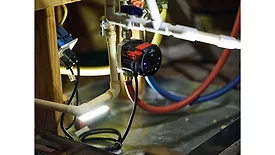Green Plumbing and Mechanical
Polymer piping systems offer durability and sustainability for commercial projects.
Read More
Case Study
Hot water in seconds — boosting comfort while saving water
Grundfos’ versatile solution improves hot water supply while reducing the environmental footprint.
July 15, 2024
Heat pump water heaters: transforming contractor profits with sustainable solutions
Federal, state and local incentives increase market adoption.
June 17, 2024
How water chemistry impacts residential plumbing materials
Plumbers need to recognize that water chemistry varies from municipality to municipality.
April 15, 2024
Master the basics of sewer root removal
Preventative maintenance and control tips.
April 10, 2024
Innovation for an important part of the home
Work with a supplier who understands the changing marketplace, and provides a full range of water heaters that meet the needs of all your customers.
April 5, 2024
Pipeline profits: Drain cleaning, pipe inspection create opportunities
New technologies simplify process for plumbers in the field.
April 4, 2024
Service Plumbing Pros | Matt Michel
Beating the scalding and legionella paradox
Plumbers can spot add-on opportunities while on calls to help protect customers.
April 2, 2024
Flowing forward: commercial pumps embrace sustainability for a greener future
Smart pump technology provides greater energy savings opportunities.
April 1, 2024
Guest Editorial | Chris Carrier
Tips and tools for 'Fix a Leak Week' and beyond
March 20, 2024
Keep your content unclogged with our newsletters!
Stay in the know on the latest plumbing & piping industry trends.
JOIN TODAY!Copyright ©2025. All Rights Reserved BNP Media.
Design, CMS, Hosting & Web Development :: ePublishing













